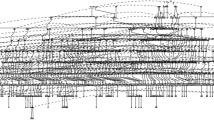Abstract
When the mtDNA profile of a crime scene matches that of a suspect, it is necessary to determine the probability of a chance match by consulting the frequencies of the identified allele in a “reference population”. The ceiling principle suggests that that population should be chosen in which the allele of the suspect is found at the highest frequency, in order to give the suspect the maximum benefit of doubt. Recently, we advocated the use of a worldwide mitochondrial database combined with a geographical information system to identify the regions of the world with the highest frequencies of matching mtDNA types. Here, we demonstrate that the alternative approach of defining a ceiling reference population on the basis of continent or phenotype (race) is too coarse for a non-negligible percentage of mtDNA control region types.
Similar content being viewed by others
References
Anderson S, Bankier AT, Barrell BG, de Bruijn MH, Coulson AR, Drouin J, Eperon IC, Nierlich DP, Roe BA, Sanger F, Schreier PH, Smith AJ, Staden R, Young IG (1981) Sequence and organization of the human mitochondrial genome. Nature 290:457–465
Call F, Le Roux MG, D’Anna R, Flugy A, De Leo G, Chiavetta V, Ayala GF, Romano V (2001) MtDNA control region and RFLP data for Sicily and France. Int J Legal Med 114:229–231
Cavalli-Sforza LL, Minch E (1997) Paleolithic and neolithic lineages in the European mitochondrial gene pool. Am J Hum Genet 61:247–251
Helgason A, Hickey E, Goodacre S, Bosnes V, Stefánsson K, Ward R, Sykes B (2001) MtDNA and the islands of the north Atlantic: estimating the proportions of Norse and Gaelic ancestry. Am J Hum Genet 68:723–737
Lewontin RC (1972) The apportionment of human diversity. Evol Biol 6:381–398
Melton T, Clifford S, Kayser M, Nasidze I, Batzer M, Stoneking M (2001) Diversity and heterogeneity in mitochondrial DNA of North American populations, J Forensic Sci 46:46–52
National Research Council Committee (1992) DNA technology in forensic science. National Academy Press, Washington DC
National Research Council Committee (1996) The evaluation of forensic DNA evidence, National Academy Press, Washington DC
Nature Genetics Editorial (2000) Census, race and science. Nat Genet 24:97–98
Pfeiffer H, Forster P, Ortmann C, Brinkmann B (2001) The results of an mtDNA study of 1200 inhabitants of a German village in comparison to other Caucasian databases and its relevance for forensic casework. Int J Legal Med 114:169–172
Pult I, Sajantila A, Simanainen J, Georgiev O, Schaffner W, Pääbo S (1994) Mitochondrial DNA sequences from Switzerland reveal striking homogeneity of European populations. Biol Chem Hoppe Seyler 375:837–840
Richards M, Côrte-Real H, Forster P, Macaulay V, Wilkinson-Herbots H, Demaine A, Papiha S, Hedges R, Bandelt H-J, Sykes B (1996) Paleolithic and neolithic lineages in the European mitochondrial gene pool. Am J Hum Genet 59:185–203
Röhl A, Brinkmann B, Forster L, Forster P (2001) An annotated mtDNA database. Int J Legal Med 115:29–39
Simoni L, Calafell F, Pettener D, Bertranpetit J, Barbujani G (2000) Geographic patterns of mtDNA diversity in Europe. Am J Hum Genet 66:262–278
Sinnott RW (1984) The virtues of the Haversine. Sky Telescope 68:159
Torroni A, Bandelt H-J, D’Urbano L, Lahermo P, Moral P, Sellitto D, Rengo C, Forster P, Savontaus M-L, Bonné-Tamir B, Scozzari R (1998) MtDNA analysis reveals a major late Palaeolithic population expansion from southwestern to northeastern Europe. Am J Hum Genet 62:1137–1152
Weber M (1922) Wirtschaft und Gesellschaft. Grundriß der Sozialökonomik III. Verlag JCB Mohr (Paul Siebeck), Tübingen, pp 216–222
Wittig H, Augustin C, Baasner A, Bulnheim U, Dimo-Simonin N, Edelmann J, Hering S, Jung S, Lutz S, Michael M, Parson W, Poetsch M, Schneider PM, Weichhold G, Krause D (2000) Mitochondrial DNA in the central European population. Human identification with the help of the forensic mt-DNA D-loopbase database. Forensic Sci Int 113:113–118
Author information
Authors and Affiliations
Corresponding author
Additional information
The authors P. F. and V. R. contributed equally to the present work.
Rights and permissions
About this article
Cite this article
Forster, P., Calì, F., Röhl, A. et al. Continental and subcontinental distributions of mtDNA control region types. Int J Legal Med 116, 99–108 (2002). https://doi.org/10.1007/s00414-001-0261-z
Received:
Accepted:
Issue Date:
DOI: https://doi.org/10.1007/s00414-001-0261-z



